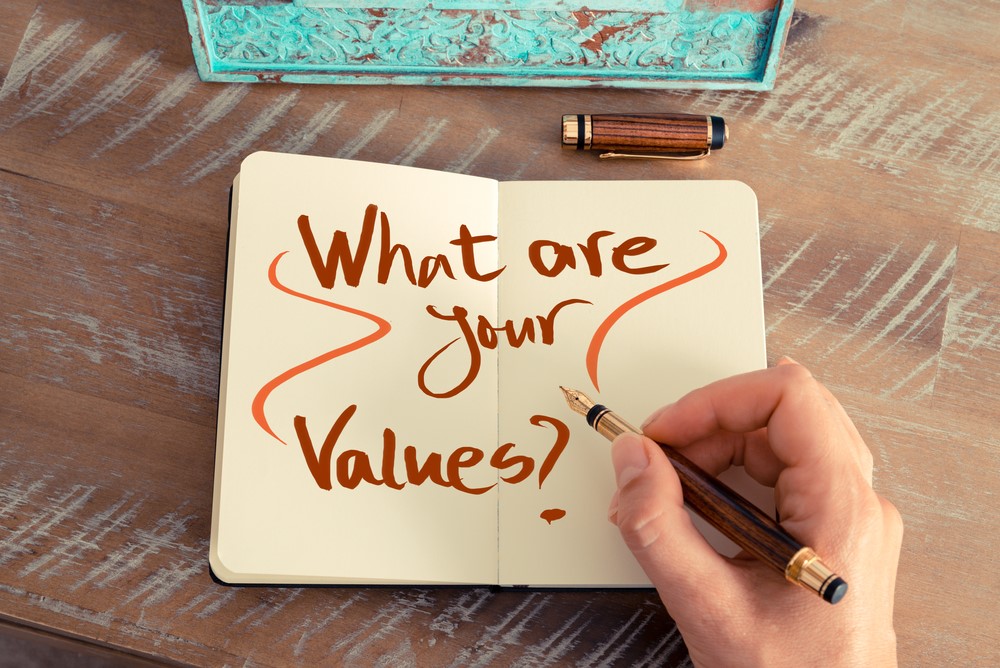
In previous posts, we’ve touched on the idea of your personal values and how these can help you to make good caregiving decisions and find meaning in your life. Today, we’re taking a closer look at values and how you can use them in your life.
First though, let’s talk about the underlying idea.
Values are the internal rules we have that help us decide what is right and wrong, what we should do and what we shouldn’t.
We all have values, they’re just not something we often think about consciously. But, when our lives don’t match our values, we start to struggle. It often feels like something is wrong, even if we don’t know what the problem is.
Coming to grips with your values can be incredibly helpful. Doing so can:
- Give you clues about how to meet those values in your own life
- Make it easier to focus on positive thought patterns
- Improve your self-discipline
- Help you make wise decisions and makes decision making easier
In this post, we’ll step you through the process of identifying and understanding your values, along with how you can use this knowledge to improve your life.
What You Need To Know
Do a little digging online and you’ll find many lists of values. Some have 100 or more entries. And, while the values are often similar from one list to the next, there are always differences as well, including:
- Which values are included and excluded on a given list
- The exact definition for the value (love, for example, can be defined in many different ways)
- Which values are combined (for example, I’ve seen joy/play included as a single value on one list, while most lists have joy as a separate value)
- How specific or broad the value is. Most lists use single words to describe values, but some use sentences instead.
This variation isn’t a problem.
Lists of values are just there to inspire you anyway. We’re all individuals and our values vary dramatically from one another. You might even find that some of your values aren’t on any list or that you need to use an unusual definition.
Also…
When you’re working with values, it’s important to look at what actually matters to you – not what you think should matter. This distinction is important, as some values are more socially desirable than others.
How To Find Your Values

Step One – Find The Values You’re Drawn To
The first step is to start making notes. Jot down values that you think might apply to you. Things that feel like they matter.
Values lists are a fantastic place to begin, like the one below. For the moment, don’t worry about how many values you choose or what they are. Just write down any that resonate with you.
Personal Values List (click to expand)
- Abundance
- Acceptance
- Accomplishment
- Accountability
- Accuracy
- Achievement
- Adaptability
- Advancement
- Adventure
- Affection
- Alertness
- Altruism
- Ambition
- Amusement
- Appreciation
- Assertiveness
- Attentive
- Authenticity
- Authority
- Autonomy
- Awareness
- Balance
- Be True
- Beauty
- Boldness
- Bravery
- Brilliance
- Calm
- Candor
- Capable
- Career
- Careful
- Caring
- Certainty
- Challenge
- Change
- Charisma
- Charity
- Citizenship
- Clarity
- Cleanliness
- Clear
- Clever
- Comfort
- Commitment
- Common sense
- Commonality
- Communication
- Community
- Compassion
- Competence
- Concentration
- Confidence
- Connection
- Consciousness
- Consistency
- Contentment
- Contribution
- Control
- Conviction
- Cooperation
- Courage
- Courtesy
- Creativity
- Credibility
- Curiosity
- Decisiveness
- Dedication
- Dependability
- Determination
- Development
- Devotion
- Dignity
- Discipline
- Discovery
- Diversity
- Drive
- Effectiveness
- Efficiency
- Fidelity
- Finances
- Finesse
- Fitness
- Focus
- Foresight
- Forgiveness
- Fortitude
- Freedom
- Friendship
- Fun
- Generosity
- Genius
- Giving
- Goodness
- Grace
- Gratitude
- Greatness
- Growth
- Happiness
- Hard work
- Harmony
- Health
- Home
- Honesty
- Honor
- Hope
- Humanity
- Humility
- Humor
- Imagination
- Improvement
- Independence
- Individuality
- Inner Harmony
- Innovation
- Inquisitive
- Insightful
- Inspiring
- Integrity
- Intelligence
- Intensity
- Intuitive
- Invention
- Involvement
- Joy
- Justice
- Kindness
- Knowledge
- Lawful
- Leadership
- Learning
- Liberty
- Logic
- Love
- Loyalty
- Mastery
- Maturity
- Meaning
- Meaningful Work
- Moderation
- Motivation
- Openness
- Optimism
- Order
- Organization
- Originality
- Passion
- Patience
- Performance
- Persistence
- Personal Development
- Playfulness
- Pleasure
- Poise
- Popularity
- Potential
- Power
- Present
- Pride in Your Work
- Productivity
- Professionalism
- Prosperity
- Purpose
- Quality
- Realistic
- Reason
- Reciprocity
- Recognition
- Recreation
- Reflective
- Relationship
- Religion
- Renewal
- Reputation
- Respect
- Responsibility
- Restraint
- Results-oriented
- Reverence
- Rigor
- Risk
- Satisfaction
- Security
- Selfless
- Self-reliance
- Self-Respect
- Sensitivity
- Serenity
- Service
- Sharing
- Significance
- Silence
- Simplicity
- Sincerity
- Skill
- Smart
- Solitude
- Speed
- Spirit
- Spirituality
- Spontaneous
- Stability
- Status
- Stewardship
- Strength
- Structure
- Success
- Support
- Surprise
- Sustainability
- Talent
- Teamwork
- Temperance
- Thankful
- This Too Shall Pass Attitude
- Thorough
- Thoughtful
- Timeliness
- Tolerance
- Traditional
- Tranquility
- Trust
- Trustworthiness
- Truth
- Understanding
- Uniqueness
- Unity
- Valor
- Vigor
- Vision
- Vitality
- Wealth
- Welcoming
- Wellness
- Willingness
- Winning
- Wisdom
You can also think about some specific areas, like the following:
Who do you admire?
Most of us have at least a few people that we admire and we want to emulate. What is it about them that draws you to them? What values do they have that matter to you?
Don’t limit yourself to people you know either. Anyone is fair game, including celebrities, characters from books, and even those from movies.
When did you feel happiest? Most complete? Most authentic?
Think about those memories and moments. What was happening at the time? What values were in play? What needs were being met?
It can help to use a variety of memories here, rather than just one or two, and look for the common features. The more memories you’re working with, the less chance that you’ll come to false conclusions.
Step Two – Start to Categorize the Values
Once you have a general list, you can start to break the values down into some rough categories, based on what they mean to you. The name for the category might be one of the values within it or something different.
For example, when I do this exercise, I end up with these values:
- Affection
- Belonging
- Compassion
- Connection
- Contribution
- Curiosity
- Family
- Flexibility
- Forgiveness
- Freedom
- Grace
- Grit
- Growth
- Honesty
- Joy/Play
- Kindness
- Love
- Loyalty
- Meaningful Work
- Personal Growth
- Practicality
- Pragmatism
- Purpose
- Resilience
- Sensitivity
- Strength
- Understanding
I can break some of these down into categories, like so:
- Love/Connection (belonging, connection, love, loyalty, family). This value includes romantic, family, and friendship-based types of connection, although romantic love is by far the most significant for me.
- Authenticity (honesty, sensitivity, curiosity, grace,). Interestingly, this value most strongly relates to the desire for other people to be authentic to themselves. It often presents in me wanting to support others and encourage their growth, while being curious about them.
- Kindness/Compassion (compassion, grace, forgiveness, sensitivity, understanding, kindness). This value includes the idea that people are very different from one another, often with their individual challenges. It’s incredibly important to love and have compassion for them as they are and to assume that they’re doing their best.
- Contribution/Direction (meaningful work, personal growth, contribution, purpose). I need life to feel like it is going somewhere. Like there’s a purpose to it and that the days and weeks are not the same thing on repeat.
- Strength/Grit (resilience, strength, flexibility, pragmatism). This includes the idea that I can do pretty much anything, that I can solve problems, even ones that seem incredibly difficult at first glance.
I ended up with five core values from the process: Love/connection, authenticity, kindness/compassion, contribution/direction, and strength/grit. You might have more or less, although between 5 and 10 core values is a common figure.
Step Three – Order the Values

This part is often the hardest one and often takes multiple attempts.
To fully take advantage of your values, they need to be in some kind of order. This way you know which ones to focus on first.
The key question is – what is the order of importance for you? Not what the order of importance should be, but what is it actually?
You might need to have a go at ranking them, sleep on it, then come back and see what you think. Try coming back to them again later on too, in a different emotional state, to see what changes and what remains the same.
For me, the order looks like this:
- Love/Connection (belonging, connection, love, loyalty, family)
- Kindness/Compassion (compassion, grace, forgiveness, sensitivity, understanding, kindness)
- Authenticity (honesty, sensitivity, curiosity, grace,)
- Strength/Grit (resilience, strength, flexibility, pragmatism)
- Contribution/Direction (meaningful work, personal growth, contribution, purpose)
Step Four – Build the Values Out
Now that you know what values matter to you, we can get creative. The goal is to explain the values a little more, focusing on words that inspire you and make you feel good.
For example:
- Love/Connection: To maintain meaningful connections with other people. To give love and affection, even if it cannot be repaid in kind.
- Kindness/Compassion: To be gentle, calm, and compassionate. To do whatever I can to help people who are struggling.
- Authenticity: To embrace the beautiful differences in people (including myself) and all of their quirks, without judgment.
- Strength/Grit: To be engaged and even joyful in the face of life’s challenges, to know that difficulties make me stronger and that they will always pass.
- Contribution/Direction: To ensure that some of my time is spent on meaningful work, on tasks that help other people and that have forward momentum to them.
Step Five – Review and Tweak
Once again, it’s important to keep coming back to your list of values. Have a look at it in different contexts and emotional states to see how it sits with you.
You’re likely to need to tweak the values over time. That’s completely fine and to be expected.
Using Values to Build a Meaningful Life

One reason for talking about values is that they influence your sense of meaning and satisfaction. If your life is very different than your values, it may feel empty and pointless.
Once you know your values, you can start finding more ways to meet them.
Some values will be easy to meet, while some may be much more difficult.
I consider myself lucky that most of my values naturally align with caregiving. Because of this, being a caregiver felt meaningful and gave me a surprising amount of joy (on the flipside though, my value structure means that I struggle when I’m single, as I have fewer opportunities to experience and express 3 of my 5 key values).
In contrast, if your values relate to areas like career success, recognition, or adventure, meeting these in a caregiving role is no easy feat.
Here are two approaches that can help:
Reframing
Reframing means that you’re changing the way you see a situation, the story you tell yourself. For example, Theresa from Sustainable Caregiving talks about the fact that adventures take many forms and that caregiving certainly can be an adventure.
Similarly, if one of your values relates to variety, you might start paying close attention to the little differences in each day, the little adventures and moments.
The goal is to learn how to appreciate what is happening in your life right now, rather than looking for something that isn’t.
Get Creative in Meeting Values
You can also get creative in how you meet your values.
For example, with love and connection, I have a strong desire to receive love. For a long time, this meant that I regularly felt rejected and isolated when friends didn’t reach out to me or when my partner was lost in a computer game.
I learned, however, that giving love can be as fulfilling, if not more so.
It still sometimes takes me time to slip back into the state of giving love rather than longing for it, but the more I do it, the easier it becomes.
Another example is a need for adventure or variability.
Life as a caregiver can get extremely repetitive. But, you can still find ways to make one day different to another. This could be as simple as listening to different types of music on different days.
Are Values Permanent or Changeable?
People often ask whether values are static or whether they change over time. Are they permanent things that define who you are or, like most other things, can they shift and change over time.
The answer seems to be a little of both.
First, most people experience some natural value shifts as they age and their life changes. For example, young people’s values often include adventure, excitement, and variety, which are often replaced by values of security and family later in life.
You might also go through a dramatic value change based on events in your life. For example, a traumatic event might make your value family much more than you did before.
Other values appear to be more static and might remain the same throughout a person’s life, such as compassion.
Some self-help teachers suggest that you can intentionally change your values and use these changed values to build the life that you want (like Tony Robbins in his classic book Awaken the Giant Within).
This may not be true for everyone, but it does seem like some people can change their values.
For example, I know that authenticity has become a much stronger value for me in the last few years.
Some sub-values that relate to it, including flexibility and curiosity, weren’t there at all a year or two ago. Those were things that I intentionally focused on because they were important for the current structure of my life.
Similarly, I had a much stronger focus on predictability, order, and planning. Now those areas don’t feature in my top five values at all.
If you’re interested in changing your values, Awaken the Giant Within could be a good place to begin. You can also check out this post by JD at Sources of Insight, which steps through some lessons about changing your values.
However, I recommend leaving that area alone for a while. You have enough to go on with by working within your current values. Unless your current values are extremely disruptive, it might not be the time to try and change any of them.

Leave a Reply